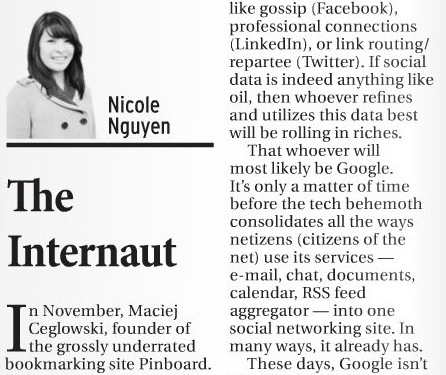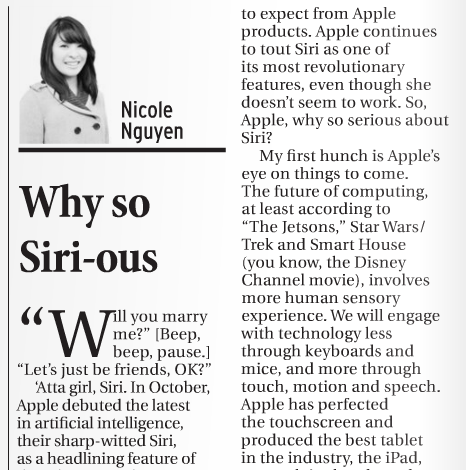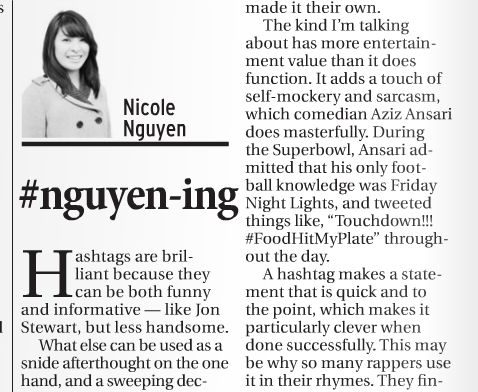Appeared in The California Aggie on January 9, 2012.
In November, Maciej Ceglowski, founder of the grossly underrated bookmarking site Pinboard.in, wrote on his blog that “asking computer nerds to design social software is a little bit like hiring a Mormon bartender.” I personally do not believe (all) computer nerds to be asocial (per se), and I disclaim this outright lest I be subject to anonymous hacking.
But when it comes to the web’s mistaken perception of human relationships, Ceglowski is absolutely right.
Take, for example, the misleading amount of “friends” you have on Facebook. Some of these “friends” are probably “nemeses” or “estranged cousins.” But because these people are, in fact, considered “friends,” built-in extensions like the Washington Post Social Reader assume you actually care that your ex-boyfriend shared “Amazing Sunset/Sunrise Photos: A Slideshow” — and that his new girlfriend liked it. You, of course, are prompted to unfriend the man and begin to resent Facebook for over-saturating your life with so much unnecessary information.
So on to the next best thing — Google+, which is aiming to correct Facebook’s sad attempts at recreating real life online by emphasizing collaborative tools and separating contacts into different circles (an exhausting effort, I might add). I feel that, at least for now, most people don’t understand how to fit Google+ into their lives as long as Facebook is still in play. It seems that our social networking energy/attention can only be truly devoted to one site at a time.
But, as Google+’s ever increasing usership proves, we’re willing to change allegiance. Forbes tech writer Venkatesh Rao likened the power of social networking to crude oil. Social networking platforms “distill” social data, Rao says, and each platform specializes in its own particular “distillate”, like gossip (Facebook), professional connections (LinkedIn), or link routing/repartee (Twitter). If social data is indeed anything like oil, then whoever refines and utilizes this data best will be rolling in riches.
That whoever will most likely be Google. It’s only a matter of time before the tech behemoth consolidates all the ways netizens (citizens of the net) use its services — e-mail, chat, documents, calendar, RSS feed aggregator — into one social networking site. In many ways, it already has.
These days, Google isn’t only trying to integrate its own connections –– it’s trying to integrate everyone else’s too. Google’s Social Graph API, which brings together users’ public connections (friends, followers, etc.) across multiple sites, is just one of Google’s many side projects. Such a tool would help developers create platforms wherein your “friends” from other sites are already pre-loaded. Eventually, the graph would adjust in tandem with real-life relationships between people. In other words, the most fundamental of human experiences — in code. Business opportunists and sociologists would rejoice.
The operative word here is “eventually”, seeing as the complexity of such a graph has not yet been realized. Google’s Social Graph uses open standards whose makeup is incredibly limiting as it exists now. Existing definitions (<co-worker>, <acquaintance>, <neighbor>, etc.) are much too literal. Ceglowski also pointed out the restricting nature of the standards’ gender nodes (<male> or <female>) and how modern relations (like <stepmom>) are missing.
But maybe there’s an argument to be made for social networks’ massive simplification of actual social relationships. A graph’s purpose is, after all, to make complicated concepts easy to understand and digest. Sometimes that means omitting certain information. Social networking platforms, at least in theory, aim to make online interaction as easy as possible, and today that means bringing relationships back to a fundamentally basic level.
So, while we’re waiting for computers to make personal connections for us, we’ll just have to do it for ourselves.
NICOLE NGUYEN doesn’t have anything against Mormon bartenders either. Know one? Contact niknguyen@ucdavis.edu.


